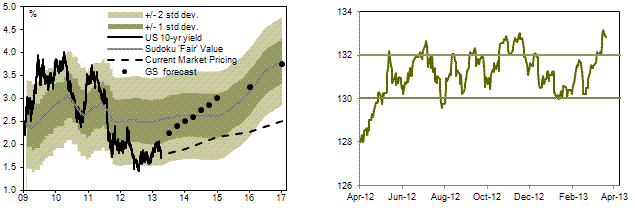– Goldman Buying Gold, Selling Treasurys To Muppets Whom It Advises To Do Opposite (ZeroHedge, April 10, 2013):
There was a brief period of confusion for a while when Goldman didn’t have clear muppet-stomping trades on the book, and those who wished to frontrun the Goldman prop desk (and do the opposite of the muppet flow) were stuck furiously scratching their head. And granted while it’s not a “Stolper”, tonight we got two gifts (in the parlance of Whitney Tilson) with Goldman first telling its clients to sell gold following Goldman’s lowering of its price target for the yellow metal (which as always means the hedge fund known as Goldman is buying what its clients are selling). And then, moments ago, we also learned that Goldman is also selling the 10 Year, which it advise muppets to buy.
First on gold:
Given gold’s recent lackluster price action and our economists’ expectation that the acceleration in US growth later this year to above-trend pace will support US real rates, we are lowering our USD-denominated gold price forecast once again. Our new forecast is further below the forward curve with year-end targets of $1,450/toz in 2013 and $1,270/toz in 2014. As a result, we recommend closing the long COMEX gold position that we first initiated on October 11, 2010 for a potential gain of $219/toz, with the risk reversal overlay expired on March 25. Our long-term gold price forecast (2017+) remains at $1,200/toz: while higher inflation may be the catalyst for the next gold cycle, this is likely several years away.
Or several months ago if you are the price of unleaded gas in Tokyo and pretty much anything else. It gets better:
While there are risks for modest near-term upside to gold prices should US growth continue to slow down, we see risks to current prices as skewed to the downside as we move through 2013. In fact, should our expectation for lower gold prices continue to prove correct, the fall in prices could end up being faster and larger than our forecast, as aggregate speculative net long positions across COMEX futures and gold ETFs remain near record highs. We therefore recommend initiating a short COMEX gold position as our ECS Top Trade #8, implemented through an S&P GSCI® front-month rolling index to further benefit from the contango in the COMEX futurecurve, targeting a move to $1,450/toz with a stop at $1,650/toz. While we may be end up too early in entering this trade, we prefer that to being late given our belief that the skew to current prices is to the downside.
Remember, however, to please execute the trade with your friendly Goldman trader, who will gladly buy all the gold you have to sell all the way down to $1450.
And just out moments ago, Goldman goes bearish (like everyone else) on the 10 Year – because you see, nobody has heard of the perpetually wrong “Great Rotation” call in 2010… or 2011… or 2012…. or 2013… Or at least Goldman clients haven’t. And apparently not the Fed, which just can’t get enough of buying just this.
We recommend going short 10-year US Treasuries via June futures (TYM3) at the current level of 132-20 for an initial price target of 130-00 and stops on a close above 134-00. In yields space, the corresponding move is from the current 1.76% to around 2.10%, and stops on a close around 1.60% – corresponding to the lows from last November.
The rationale for our recommendation rests on the following four considerations:
- The valuation case for shorting Treasuries has become more compelling after the decline in yields following a worse-than-expected US jobs report and the BoJ’s easing. Our assessment of the macroeconomic outlook for the US and the main advanced economies has not changed; if anything, it has improved following the large fiscal and monetary stimulus in Japan.
- The market appears to have already factored in a softening in US growth during the second quarter, after a stronger-than-expected first quarter. Our US GDP Growth Basket (a ‘tracking portfolio’ of US real GDP growth) has retraced all the gains recorded between last November and mid-February. This should protect the trade should the forthcoming batch of macro data, starting with retail sales this Friday, be weaker than earlier in the year. That said, a near-term risk to the trade stems from an escalation of tensions in North Asia. So far, these developments appear to have had a small impact on global asset prices.
- We think the most persistent part of the BoJ’s ‘surprise’ is a flattening of the 10s-30s segment of the yield curve. This is mostly a domestic play, with limited spill-over effects for overseas fixed income markets. We have likened this move to that resulting from the Fed’s ‘Operation Twist’: the slope of the ultra-long-end of the Treasury has remained in a 60-80bp range, while the level of 10-year yields has moved around. Interestingly, 10-year Japanese yields are heading back to pre-BoJ announcement levels.
- Treasury bond futures have tried to break above the upper end of a broad price range in place since July 2012, and failed. Short positioning in the rates market is lighter, according to anecdotal evidence.
Thank you Goldman – we can always rely on you.

